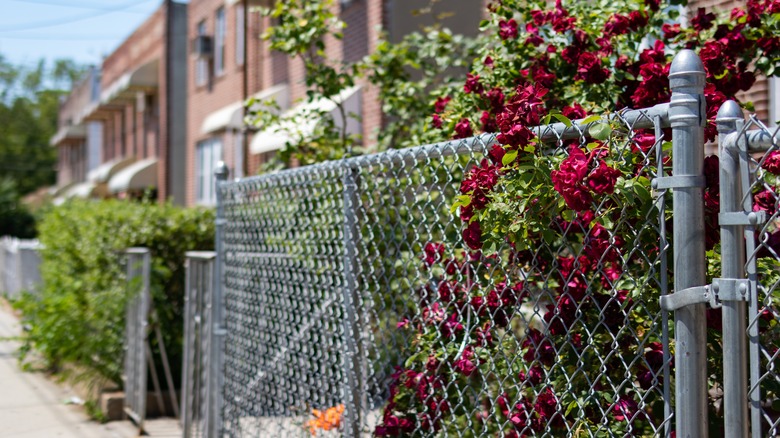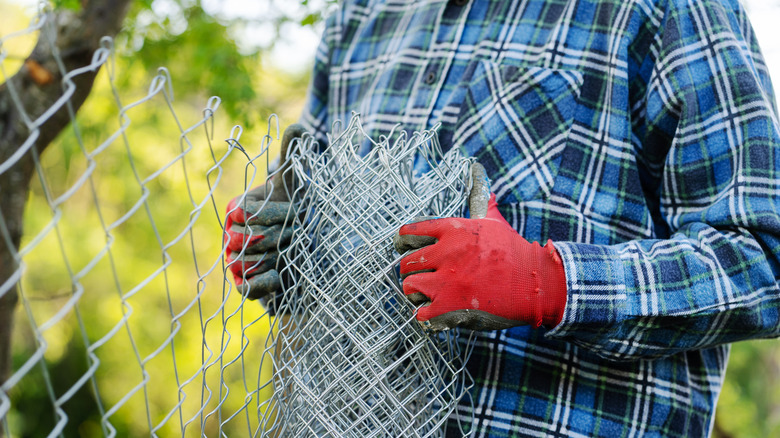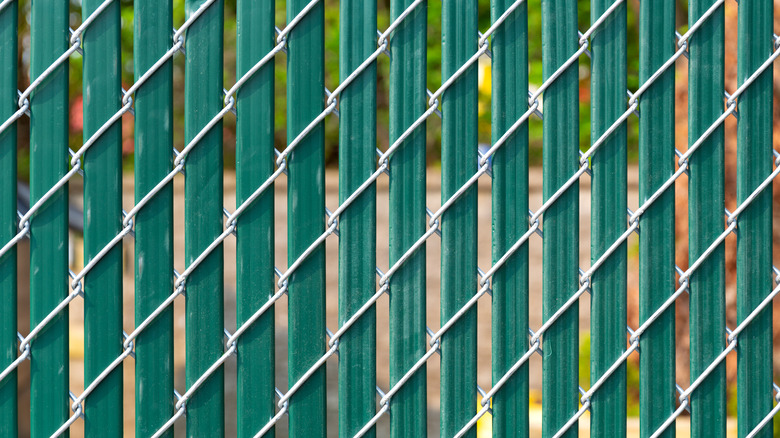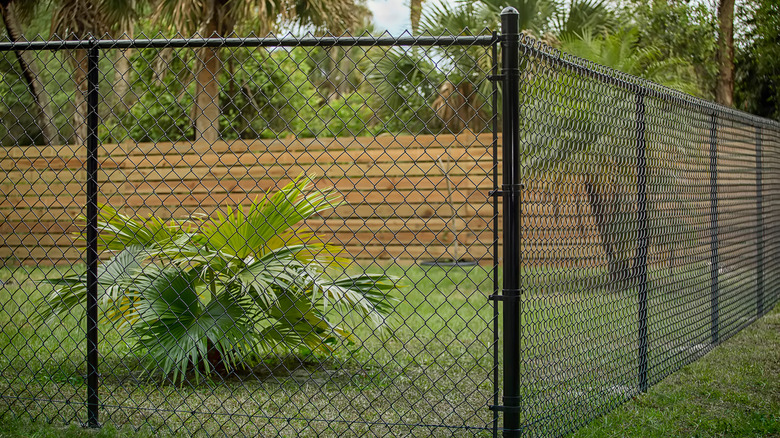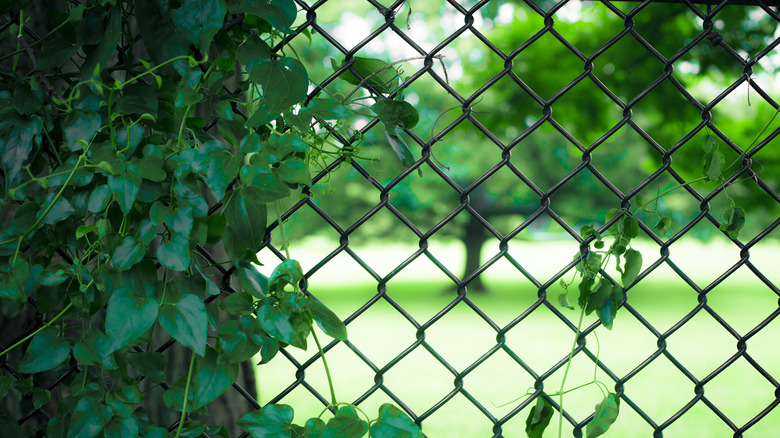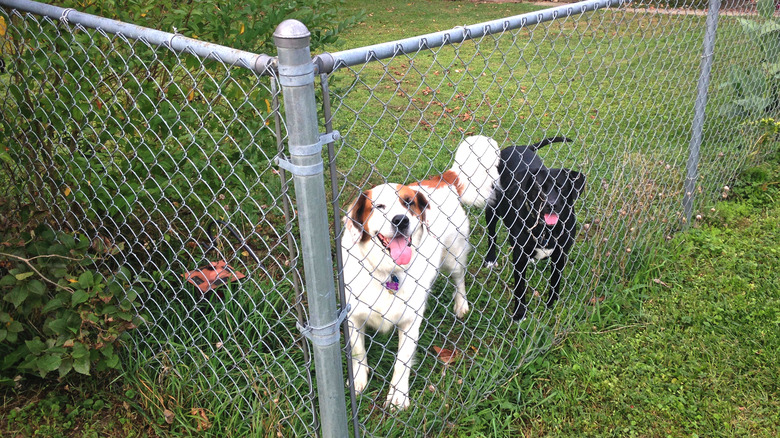How Much Does It Cost To Build A Chain-Link Fence?
Chain-link fences are a common choice for homeowners, due largely to the perception that they are more of a cost-effective option than other fencing choices, such as wooden fences or iron fences. But is this belief true? HomeAdvisor reports that the average cost to build a chain-link fence is around $2,200, with total costs usually ranging from $1,300 to $3,400, depending on a variety of factors. If you are looking to build an unusually tall chain-link fence, or one made out of a particularly thick gauge of metal, you will probably end up paying more, potentially over $5,000.
Chain-link fencing cost can also be broken out by linear foot. Materials to build a chain-link fence can run anywhere between $5 and $20 per linear foot, with installation costs costing between $10 and $20 per linear foot.
Chain-link fences may all look mostly the same, but their cost can vary quite a bit depending on the specific type of metal used in their construction. The gauge, or the thickness of the metal strands in the sheets of chain links, is what differentiates different types of chain-link fences, according to Angi. Most owners of residential properties choose to go with a 5-gauge fence, which is on the thinner end of the spectrum and typically costs a bit less. Homeowners who are installing a chain-link fence primarily for security purposes may scale up to a 9-gauge fence. Commercial properties usually end up somewhere in the middle, with a 6-gauge or 7-gauge metal thickness.
Factors for cost
There is no standard set fee for building a chain-link fence, as costs can range depending on a variety of different situations, from where you put your fence to how you choose to construct it.
Location
You hear it all the time in real estate –- location, location, location. When it comes to building a fence, location can impact your costs in two different ways. First, the greater area where your fence is going to be located, e.g. the city and state in which you live, can have a large impact on your overall price, as the cost of labor and materials will likely be higher in places where the cost of living is also higher. But, more importantly, the specific physical location of your future fence will affect its price. HomeServe explains that factors such as the slope of the ground on which you are planning to construct, and the type of soil into which you will be driving your fence posts can have huge impacts on your fence's overall cost.
If you are building a fence on a slope that is exceptionally steep, you may need to level out your land before you can even begin fence construction. Leveling out your yard can cost anywhere from $500 to $5,000, depending on how large the stretch of land in question may be. Similarly, if your soil is rocky or full of clay, you will probably end up paying quite a bit more — either because your contractor will charge you more due to the difficulty of working with the soil, or because it will take them longer to dig through the soil, and so you will end up paying for more hours of labor. And if you choose to build your chain-link fence yourself, you may not pay for the rocky soil in dollars, but you will certainly have to pay for it in time spent.
Fence height and length
Unlike most other kinds of fences, chain-link fences do not have a standard height, reports HomeAdvisor. Chain-link fences are often the fence of choice for commercial fencing needs, which may explain the variance in their heights. For anyone looking to build a chain-link fence, they should keep in mind that the taller their fence becomes, the more it will ultimately end up costing them. HomeAdvisor's breakdown of the relationship between fence height and cost explains that a 4-foot fence will cost between $8 and $20 per linear foot, a 5-foot fence between $9 and $22, a 6-foot fence (the standard for most residential settings) between $10 and $29, an 8-foot fence between $12 and $34, and a 10-foot fence between $17 and $40, so the sky is really the limit.
Another big factor impacting the overall cost of your chain-link fence is how long you want it to be. If you are attempting to fence in a full acre of land, your fence could end up costing you between $7,000 and $15,000. But this situation is unlikely, as fences almost never need to enclose the entire perimeter of an area, as other natural or human-made barriers such as structures usually provide some coverage. The majority of residential lots are around 1/4 acre in size. If you want to fence in the full 1/4 acre, you can expect to pay anywhere between $1,500 and $3,000. However, for most backyards, you will probably be able to get away with only 150 to 200 linear feet of fencing, nowhere near the full 1/4 acre, so you will likely pay less.
Materials and tools
Chain-link fences are one of the more simple fencing styles when it comes to construction needs, but that doesn't mean you won't have to invest a solid amount of money in your materials and tools if you choose to build your fence yourself. The mesh of your chain-link fence can vary in cost depending on gauge, as mentioned above, but will probably run you on average between $2 and $15 per linear foot, according to HomeAdvisor. You will also need metal fence posts every 8 feet, which will cost you between $15 and $25 apiece, an estimate which includes the concrete you will need to pour into the ground and set the posts in place. Chain-link fence posts also require metal post caps, which cost between $1 and $4 apiece.
The cost of tools, as opposed to materials, may be the real pain point if you are going the DIY route for your chain-link fence. To build your fence, you will need both an auger to drill the holes for the fence posts, and a cement mixer to prep the concrete to fill those holes in. If you want to own the tools for future projects, you can buy a power auger for between $60 and $600, or a manual auger for between $15 and $110. Renting the tools may make more financial sense, since you can rent both an auger and a cement mixer for between $25 and $150 per day, although keep in mind that building a chain-link fence will usually involve multiple days' worth of work -– probably 20 to 30 hours of work in total.
Labor
If you do not want to or are unable to put in all the time yourself to build a chain-link fence, contracted labor is a great option, although it too can be pricey. Angi reports that contractors tend to charge either by the hours worked or the linear foot of chain-link fence length. Average costs range from between $25 and $50 per hour, and $10 and $20 per linear foot, meaning you will probably end up paying between $1,500 and $3,000 in total for the whole job. However, it may make more financial sense in the long run for you to go with a professional contractor. If you attempt to build your chain-link fence yourself, but make costly rookie mistakes, it will likely set you back even more to have a professional come in and make repairs to your fence after the fact.
Additional costs
There are some factors that you just can't avoid when it comes to building a chain-link fence. But you need to watch out for some of the other, more hidden costs associated with fence construction as well.
Getting rid of your old fence
If you have an old chain-link fence that is beyond repair, and it's time for an upgrade, the good news is that removing and replacing a chain-link fence is a much less complicated and expensive proposition than it is with other types of fences. If your fence posts are still standing and in good condition, you can swap out the old mesh in between the posts for new mesh for usually between $10 and $25 per linear foot, according to Angi. Some contractors will include the cost of fence removal in their overall project quote, although many will not, so it's always good to ask and make sure beforehand.
The best thing about removing old mesh is that it can actually be resold, either as workable mesh if it's in good condition, or as scrap metal otherwise. You may be able to get up to $6 per linear foot of your old mesh, which can help offset the cost of your new chain-link fence.
Addressing landscaping and other natural barriers
It is unfortunately pretty rare for fence construction to be entirely straightforward, and for your fence to be enclosing a neat, well-defined area without any existing barriers. If you have bushes, shrubs, or basically any other plant besides grass that could get in your fence's way, you are going to have to remove those prior to construction beginning, which will probably cost you anywhere between $1,400 and $5,500, reports HomeAdvisor. Trees can also be a big problem, with tree removal running between $200 and $2,000, depending on the size of the tree. If you have to work around existing structures, such as your house, your driveway, or a backyard shed, expect your contractor to tack on anywhere between $2 and $5 per linear foot for those sections of your fence.
Corners, varied heights, and other twists and turns
Let's say you have cleared your yard of both natural and human-made barriers to your fence, but you still are not exactly working with a perfect square area to fence in -– as is true of most homeowners and yards. Keep in mind that for every corner on your fence, your overall costs will go up, as that will require another hole to be filled with cement, another fence post, and another fence post cap. Similarly, if you want different parts of your fence to be different heights -– for example, if instead of cutting down a tree, you want to lower your fence height to accommodate its branches –- that situation will ultimately end up costing you more as well.
Permits
Your permitting requirements will vary depending on where you live. Many homeowners will not need to pay for fence permits at all, although you should always double- and triple-check beforehand, since the cost of a fine for building without a permit will often be significantly higher than the cost of the permit itself. If you live in an HOA community, you will likely find that you need a permit if you plan to build a fence that is anywhere over 6 feet tall. Permits cost around $40 on average, according to HomeGuide, though this is one price point with quite a wide range, depending on the municipality where you reside.
Gates
It would be kind of useless to fence in an area and then not be able to access it, right? Odds are, you are going to want to include at least one gate in your chain-link fence. HomeAdvisor reports that if you choose to install a gate yourself, you will probably spend anywhere between $50 and $320 on the required materials. If you pay for the labor of gate installation, that will end up costing you between $100 and $450.
Keep in mind, though, that those estimates are for basic residential gates, usually only wide enough for a couple of people to pass through. You may need to seek a slightly larger gate to make sure you can accommodate your trash cans, lawn mower, or any outdoor furniture you may be transporting through your fence's gate. If you are looking for an automatic rolling gate, commonly used to fence in part of your driveway or for an RV pad, you will end up spending between $500 and $1,800 for a gate large enough to drive a vehicle through.
Privacy slats
The biggest drawback to a chain-link fence, as opposed to other kinds of fences, is that they are completely transparent. If you want to add privacy slats to your fence to reduce its transparency, those will also end up costing you more. HomeAdvisor reports that the cost of slats on their own is usually between $3 and $5 per linear foot, though if you include them in the cost of labor and a contractor, your price will be closer to between $5 and $15 per linear foot. Privacy slats can be made of aluminum, redwood, or vinyl. Vinyl is the most common and is typically available in either green or black to blend in with a fence's surroundings.
Types of chain-link fences
Beyond the thickness of the metal gauge in the chain link, there are a few other ways to differentiate chain-link fences. Angi provides a good breakdown of the different chain-link fence types.
Galvanized chain-link fences
Galvanized chain-link fences are the standard chain-link fence option, exactly what pops into your mind when you think of the phrase "chain-link fence." These fences are on the cheaper end of the chain-link spectrum, usually running between $5 and $15 per linear foot.
Hurricane or cyclone chain-link fences
Chain-link fences in the South and the Midwest are often referred to as hurricane or cyclone fences. These fences are made out of the same galvanized mesh as standard chain-link fences, but their fence posts are larger, stronger, and more reinforced to withstand the intense winds associated with hurricanes and cyclones in these regions. Because these fences are hardier than other types of chain-link, they also cost more, anywhere between $8 and $40 per linear foot.
Vinyl coated chain-link fences
In coastal areas, it is common to coat the metal chain-link mesh on a fence with a vinyl covering to prevent the rusting and corrosion from ocean fog and the marine layer. Purchasing vinyl coated chain link can cost you between $15 and $40 per linear foot, although the higher upfront cost makes more sense when you consider the long-term costs of rust damage.
Why you need a new chain-link fence
Nothing lasts forever, and that adage certainly applies to chain-link fences. There are a variety of reasons why it may be time for you to step up and replace that old chain-link fence with a sparkly new one.
Rust damage
The biggest enemy of any metal fence is, of course, rust. Angi reports that rust is particularly common in moist, humid, or rainy environments, and if the chain-link on your fence becomes corroded enough, it can actually become dangerous to handle or touch due to the risk of injury and tetanus infection. Rust also degrades the quality of the fence's metal, making it more susceptible to damage and increasing the likelihood of parts of the fence eventually falling down. Rust and corrosion can be prevented by spraying a rust-resistant coating protection on your chain-link fence about once a year, but if the rust has already set in, it may be time to invest in a new fence.
Climbing damage and wear and tear
We all have memories of scaling chain-link fences as a kid. If you want your fence to last for the long haul, though, you should dissuade anyone from climbing it for any reason. Climbing puts pressure on the chain-link mesh, which can warp, but is fairly easily replaced. Less easily replaced are the metal fence posts, which can also tilt and slide under the pressure of constant climbing.
Ivy damage
Many people are attracted to ivy and other climbing plants as natural, cheap ways to add privacy to their chain-link fence and avoid the extra cost of privacy slats. But be warned: Ivy can eventually take a toll on your fence's health. SFGate reports that, over time, ivy can become so overgrown that it becomes an eyesore, and worse, it grows so heavy that it can slowly start to pull your fence over. Ivy can be extremely complicated to remove once it is attached to a chain-link fence, as you will have to disentangle its individual vines and likely apply weed killer to the roots, which can also run the risk of hurting nearby plants as well. Best to avoid ivy on your chain-link fence entirely if possible.
Impact damage
The most common cause of fences falling over is damage from impact due to a storm, reports Connect2Local. Even if you have invested in a hurricane or a cyclone fence, a falling tree, flying debris, or even exceptionally strong winds still have the potential to take your fence out. Keep in mind that if you add privacy slats to your chain-link fence, strong winds can become even more dangerous of a factor, as the fence now has a greater surface area since it no longer has multiple openings the wind can blow through.
Benefits of chain-link fences
It's important to note that, with all the associated costs of chain-link fences, there are some significant financial and other benefits as well. Homes.com provides a roundup of all the good reasons you should choose to invest in a chain-link fence.
Resale value and curb appeal
More and more potential home buyers are drawn to homes with pre-existing fences, so that they don't have to go through all of the trouble of securing materials and labor to install one themselves. Additionally, the majority of future homeowners either already have a dog or plan to adopt one in the near future, and a fenced-in area for the dog to run and play provides massive curb appeal for these prospective buyers. Building a chain-link fence could be a solid investment in your home's resale value in the long term.
Privacy
If you choose to build a chain-link fence with included slats, you will have instant increased yard privacy. Privacy can be particularly important for activities like hot tubbing or entertaining houseguests. You may also feel more comfortable storing expensive items, such as your bike, in your backyard if you know that it is difficult for people to see past your fence.
Safety
Of course, one of the biggest benefits of installing a chain-link fence is the sense of safety it provides. Whether that is keeping your dog or your small children safe from passing cars or other dangers of the outside world, or keeping your yard safe from wild animals or intruders, you can't really put a price on the sense of security provided by a strong chain-link fence.
